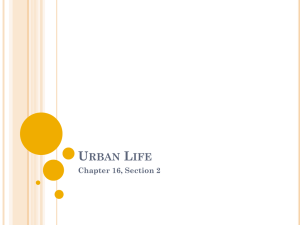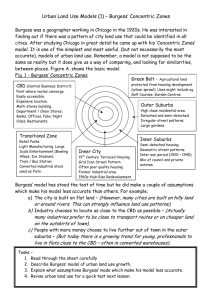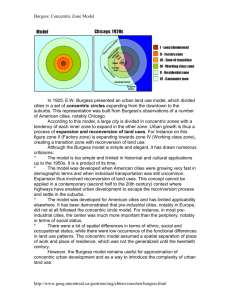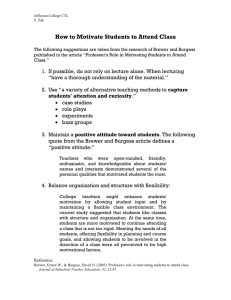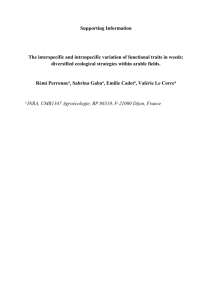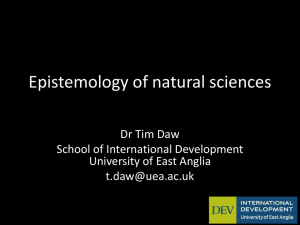Chapter 4
advertisement
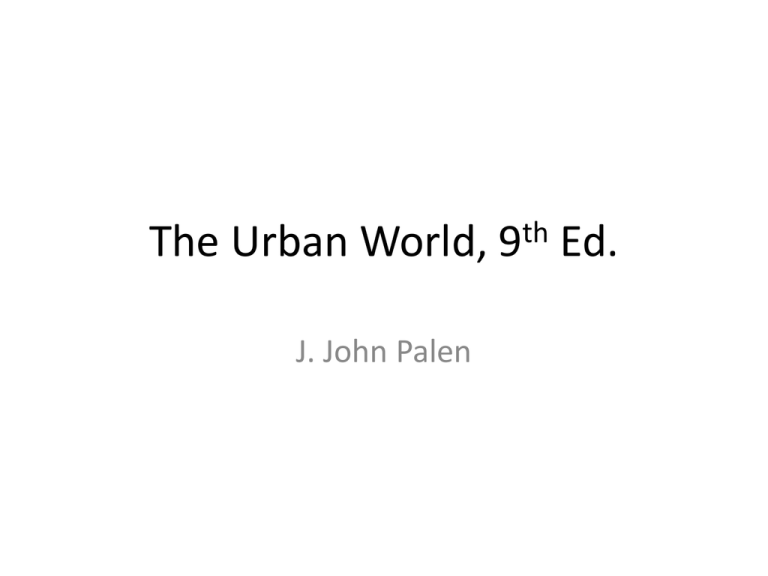
The Urban World, J. John Palen th 9 Ed. Chapter 4: Ecology and Political Economy Perspectives • • • • • • • • • • Introduction Development of Urban Ecology Burgess's Growth Hypothesis Sector and Multiple-Nuclei Models Urban Growth Outside North America The Postmodern City: The Los Angeles School Political Economy Assumptions Examples of the Political Economy Approach Challenges Summary Introduction • Sociologist Louis Wirth’s attempt to view a city’s spatial physical structure, its forms of social organization, its peoples and lifestyles, and its problems empirically through three interrelated perspective • This chapters looks at the spatial and social structure of the city and how it affects and is affected by the city as a system of social organization Development of Urban Ecology • Invasion and Succession – Viable communities are always in the process of changing – Invasion of one land use or population by another – Succession: when one group or function finally takes the place of another – Natural Areas: segregated urban areas that are supposedly the result of ecological processes rather than of planning or conscious creation by a government unity • Criticisms of Ecology – The heavy emphasis on competition in traditional human ecology, plus the nonsocial nature of some of the variables, disturbs contemporary political economy critics • Role of Culture – Ecology’s macro-level focus may fail to explain the cultural and motivational factors in urban land-use patterns Burgess’s Growth Hypothesis • From the Chicago School • First presented in 1924 • Suggested that industrial cities grew radically through a series of concentric zones • This is not a model of how things are as much as a model of how things change Figure 4.1 Burgess's Zonal Hypothesis Concentric Zones • Zone 1 – Central business district • Zone 2 – Zone in transition • Zone 3 – Working people’s homes • Zone 4 – Zone of the better residences • Final Zone – Commuter zone Limitations • Criticized for having arbitrary divisions • Must keep in mind that Burgess proposed a “model” or “ideal type” of what American cities would look like if other factors did not intervene Sector and Multiple-Nuclei Models • Based of his study of 142 cities, Homer Hoyt proposed a “sector theory” – Used pie-shaped wedges or sectors – Focuses attention of the role of transportation arteries • Chauncy Harris and Edward Ullman argued that land-use patterns developed around what were originally independent nuclei – Today, the multi-nuclei hypothesis provides a better description of the entire metropolitan area than it does of the central city Urban Growth Outside North America • In cities with a nonindustrial heritage, there appears to be an inverse zonal hypothesis – For example, in Paris, housing projects are located in the suburbs • Burgess’s theory does not appear to be applicable to older European cities – Heavy industry confined to suburbs because of densely populated central land The Postmodern City: The Los Angeles School • In direct opposition to the Chicago School • Argues that LA, with its fragmented spatial and social patterns is the model for the future—the new pattern • Critics state that this statement slips from science into an academic boosterism that is at odds with empirical research and critical theory Political Economy Models • Political economy advocates argue that you have to look beyond the city to national (and possibly world) patterns to understand massive changes such as city declines, suburbanization, or deindustrialization • Focuses on the role played by human agency, and especially the actions of the corporate economic elites and political institutions that do their bidding Figure 4.2 Urbanization in the World System Model of how macrostructures set the parameters for urban development. The image of smaller “windows” of possible variability, instead of deterministic causal arrows, is chosen because this figure is intended to provide a general theoretical orientation for research (i.e., to point to the key elements), rather than pretend to provide a verifiable model for testing. Political Economy Assumptions • 5 underlying assumptions taken from the work of Joe Feagan and modified by David Smith and Michael Timberlake – Cities are situated in a hierarchical global system, and global linkages among cities help define the structure of the world system – The world system is one of competitive capitalism – Capital is easily moved; locations of cities are fixed – Politics and government matter – People and circumstances differ according to time and place, and these differences matter Examples of the Political Economy Approach • The Baltimore Study – David Harvey stated that financial capital rather than industrial capital determines the future of the city • Urban Growth Machines – John Logan and Harvey Molotch looked at the necessity to create a “good business climate” – Local governments are largely in the pockets of major economic interests, paying little attention to local residents concerns • World Systems Theory and Globalization – World systems theory suggests that what happens to individual cities is not a result so much of what happens in their own region as to where these cities fit into the world hierarchy of cities – Hierarchy is based upon the economic power the city commands • Challenges – The challenge of the political economy model is to adapt what began as a neo-Marxist model to a world that has largely abandoned Marxism
